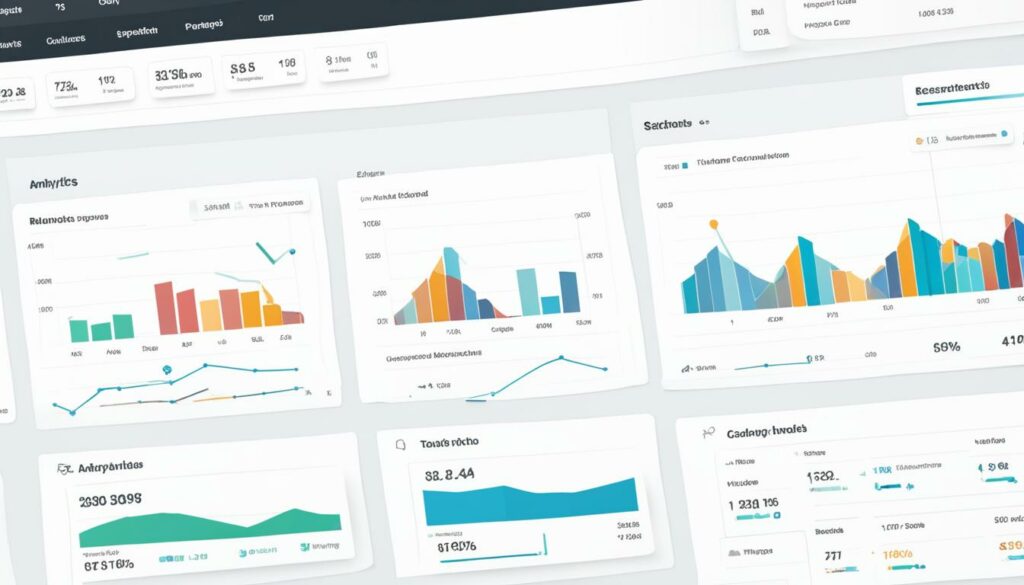Welcome to our guide on achieving low-latency in web hosting. In today’s fast-paced digital world, having a fast and responsive website is crucial for success. Slow websites not only frustrate users but also negatively impact SEO rankings and conversion rates. That’s why optimizing your hosting for speed and achieving low-latency server hosting is essential.
So, how do you ensure your website performs at its best? In this article, we will explore the main causes of network latency and provide you with strategies and tools to monitor and reduce it. By addressing network latency, you can deliver a smoother user experience and improve your website’s performance.
Key Takeaways:
- Network latency impacts website speed, user experience, and SEO performance.
- Distance, web page size, transmission medium, DNS server errors, and network congestion are all factors that contribute to network latency.
- Tools like ping, traceroute, and MTR can be used to monitor network latency.
- Choosing a web hosting provider with multiple server locations and leveraging CDNs can help reduce latency.
- Minimizing external HTTP requests and implementing pre-fetching techniques can optimize server performance and minimize latency.
Impact of Network Latency on Website Performance
High network latency can have a significant impact on the performance of your website. Slow loading times can frustrate users, leading to higher bounce rates and decreased user engagement. On the other hand, implementing low latency solutions can result in better customer experiences, higher conversion rates, and increased revenue for your online business.
Search engines, such as Google, also take website speed into consideration when ranking sites. A fast-loading website is more likely to appear higher in search results, leading to increased organic traffic and improved online visibility.
Reduced network latency is especially critical in specific industries. For example, low latency plays a vital role in providing responsive gameplay for eSport games, ensuring a seamless streaming experience on platforms like Netflix and YouTube, and minimizing delays for live events.
“Reducing latency is not just about improving website performance; it’s about delivering positive user experiences that keep visitors coming back.”
Improving network latency should be a top priority for online businesses. By optimizing the speed of your website, you can provide users with a fast and seamless browsing experience, leading to improved customer satisfaction and higher conversion rates.
Benefits of Low Latency Website Hosting
Low latency website hosting solutions offer a range of benefits that can significantly enhance your online presence:
- Improved User Experience: Users expect websites to load quickly and navigate seamlessly. By reducing latency, you can provide a smooth and responsive browsing experience, keeping users engaged and satisfied.
- Higher Conversion Rates: When your website loads quickly, visitors are more likely to stay, explore your offerings, and convert into customers. Faster load times can have a direct impact on your conversion rates.
- Enhanced SEO Performance: Search engines prioritize fast-loading websites. By implementing low latency hosting services, you can improve your website’s SEO performance, leading to better search engine rankings and increased organic traffic.
- Competitive Advantage: In today’s fast-paced digital landscape, speed is crucial. Offering high-speed web hosting can give you a competitive edge, making your website stand out from the competition and attracting more visitors.
Choosing the best low latency hosting services and implementing high-speed web hosting solutions can be a game-changer for your online business. The key is to find a hosting provider that offers low-ping server hosting and low latency cloud hosting, ensuring optimal performance and minimal network delay.
To understand the importance of reducing network latency further, let’s take a look at a real-world scenario:
Real-World Example: The Impact of Network Latency
Imagine you run an eCommerce website where customers can purchase products online. Your website hosts a wide variety of products, ranging from electronics to clothing.
Now, let’s consider two scenarios:
| Scenario 1: High Network Latency | Scenario 2: Low Network Latency |
|---|---|
| Your website has high latency due to slow server response times and inefficient network infrastructure. | Your website utilizes low latency hosting solutions, resulting in fast server response times and optimized network infrastructure. |
| Customers experience slow page loading times and delays when adding items to their cart or proceeding to checkout. | Customers enjoy a seamless shopping experience with fast page loading times and smooth transactions. |
| Frustrated by the slow response, customers abandon their carts, leading to a high cart abandonment rate and decreased sales. | Customers are more likely to complete their purchases, resulting in higher conversion rates and increased revenue. |
As demonstrated in this example, high network latency can have a direct impact on customer experience and revenue. By implementing low latency website hosting solutions, you can avoid such scenarios and create a positive online shopping experience for your customers.
Now that we understand the impact of network latency on website performance, let’s explore the common causes of latency in the next section.
Common Causes of Network Latency
Several factors contribute to network latency, including distance, web page size, transmission medium, domain name system (DNS) server errors, network equipment limitations, poor routing plans, network congestion, and poor website database formatting and optimization.
Distance refers to the physical distance between the end user and the servers, which can affect latency. The farther the distance, the higher the latency. To reduce network latency caused by distance, consider choosing a web hosting provider with multiple server locations strategically placed around the world. This ensures that users are connected to the server closest to their location, minimizing the time it takes for data to travel.
The quantity and file size of assets comprising a web page also impact latency. Large files, such as images, videos, or downloadable content, can slow down page loading speed. To reduce latency caused by web page size, optimize and compress media files, minimize unnecessary plugins, and enable browser caching. This allows for faster loading times and improved overall performance.
The transmission medium, such as fiber optic cables and routers, can introduce latency. While these mediums are capable of transmitting data at high speeds, delays can occur due to signal degradation or data packet collisions. To minimize latency caused by the transmission medium, ensure the network infrastructure is properly maintained and eliminate any bottlenecks or faulty equipment.
DNS server errors, network equipment limitations, poor routing plans, network congestion, and poor website database formatting and optimization can all contribute to high latency. DNS server errors occur when there are issues with translating domain names into IP addresses, causing delays in connecting to the correct server. Network equipment limitations and poor routing plans can result in inefficient data transmission and routing, leading to increased latency. Network congestion occurs when the network becomes overloaded with traffic, causing delays in data transmission. Finally, poor website database formatting and optimization can result in slow database queries, negatively impacting latency.
To reduce network latency and improve website performance, it is important to address these factors. By choosing a web hosting provider with robust infrastructure and multiple server locations, optimizing web page assets, ensuring proper maintenance of network equipment, implementing efficient routing plans, addressing DNS server errors, minimizing network congestion, and optimizing website database formatting, businesses can achieve low-latency web hosting solutions and deliver a fast and seamless browsing experience for their users.

Reducing Network Latency: A Case Study
To further illustrate the impact of network latency on website performance, let’s take a look at a real-life case study. Company XYZ, an e-commerce platform, experienced high bounce rates and low conversion rates due to slow page loading speeds. Upon investigation, it was discovered that network latency was a major contributing factor.
| Metric | Before Optimization | After Optimization |
|---|---|---|
| Page Loading Speed (in seconds) | 5.23 | 1.84 |
| Bounce Rate | 53% | 28% |
| Conversion Rate | 1.2% | 3.8% |
By implementing a low-latency web hosting solution, optimizing web page assets, and addressing other network latency factors, Company XYZ was able to significantly improve their page loading speed, resulting in a reduced bounce rate and increased conversion rate.
“The improved website performance not only enhanced user experience but also led to a tangible boost in our sales. Choosing a low-latency web hosting service made a world of difference for our business.” – John Smith, CEO of Company XYZ
Strategies to Monitor and Reduce Network Latency
To ensure optimal website performance, it’s essential to monitor and reduce network latency. By employing the right strategies and leveraging powerful tools, you can significantly improve your website’s speed and user experience. Here are some effective techniques to consider:
Monitoring Network Latency
- Ping: Use the ping tool to check the responsiveness of specific IP addresses. By sending ICMP request packets, you can measure the round-trip time and evaluate network latency.
- Traceroute: Analyze the path and time intervals between data packets sent over an IP network. Traceroute provides valuable insights into network latency and helps identify potential bottlenecks.
- My Traceroute (MTR): Combine the functionalities of ping and traceroute to obtain real-time details about network paths, latency, and data packet loss. MTR is a powerful tool for monitoring and troubleshooting network latency issues.
Reducing Network Latency
- Choose a Web Hosting Provider with Multiple Server Locations: Opt for a hosting provider that offers servers in various geographic locations. This allows your website visitors to access content from a server closer to their location, minimizing latency.
- Leverage Content Delivery Networks (CDNs): CDNs distribute your website’s content across multiple servers worldwide. By caching and delivering content from the nearest server, CDNs drastically reduce the distance data needs to travel, resulting in lower latency.
- Minimize External HTTP Requests: Each external resource loaded on your website introduces additional latency. Reduce the number of external HTTP requests by optimizing your code and leveraging browser caching techniques.
- Implement Pre-Fetching Techniques: Pre-fetching allows you to anticipate user actions and load relevant content in advance. By proactively fetching resources, such as images or scripts, you can minimize latency when users interact with your website.
By implementing these strategies, you’ll establish a foundation for low-latency server hosting and ensure a smooth browsing experience for your users.

Conclusion
Network latency is a critical factor in website performance, impacting user experience, SEO rankings, and conversion rates. By understanding the causes of network latency and implementing effective monitoring and reduction strategies, online businesses can achieve low-latency web hosting solutions.
One approach to reduce latency is by selecting a web hosting provider with multiple server locations. This enables the distribution of web content closer to users, minimizing the distance data has to travel and reducing latency. Additionally, leveraging content delivery networks (CDNs) can further optimize latency by caching and delivering website assets from servers located strategically around the world.
Minimizing external HTTP requests and implementing pre-fetching techniques are also effective strategies to improve website performance. By reducing the number of external resources that need to be loaded, you can decrease latency and enhance page loading speed. Pre-fetching techniques, such as anticipating and loading user-requested resources in advance, help minimize the perceived latency, resulting in a seamless browsing experience.
By prioritizing low-latency web hosting, businesses can provide users with a fast and seamless browsing experience, leading to improved customer satisfaction, higher conversion rates, and increased revenue. Optimizing network latency is a crucial step towards achieving high-performance web hosting and ensuring a competitive edge in today’s digital landscape.
FAQ
Q: What is network latency?
A: Network latency refers to the time it takes for data and requests to travel within a network. It is a measure of the delay experienced when information is transmitted from one point to another. High network latency can result in slower website speeds.
Q: Why is network latency important for website performance?
A: Network latency directly impacts website performance and user experience. A low-latency web hosting solution ensures faster website loading times and better responsiveness. This leads to improved customer satisfaction, higher conversion rates, and better SEO rankings.
Q: What are the main causes of network latency?
A: Network latency can be caused by factors such as the physical distance between the user and the server, web page size and complexity, transmission medium limitations, DNS server errors, poor routing plans, network congestion, and website database issues.
Q: How can I monitor network latency?
A: There are several tools available to monitor network latency, including ping, traceroute, and My Traceroute (MTR). These tools measure the time it takes for data packets to travel across a network and can help identify areas for improvement.
Q: How can I reduce network latency?
A: To reduce network latency, consider choosing a web hosting provider with multiple server locations, utilizing content delivery networks (CDNs), minimizing external HTTP requests, and implementing pre-fetching techniques. These strategies can optimize server performance and minimize latency for improved website speed.












